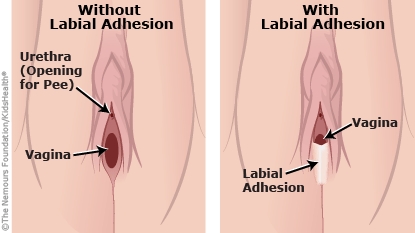Labial Adhesions: How to Care for Your Child
Labial adhesions happen when the labia minora (the inner folds of skin surrounding the vaginal opening) become fused together. Most often they're found at a baby's or young child's routine health visit by their health care provider.
Labial adhesions will go away on their own during puberty if not well before that, so they only need treatment if a large part of the labia is fused or the adhesions cause symptoms (such as trouble peeing or infections). If treatment is needed, health care providers prescribe an estrogen or steroid cream to help the adhesions come apart. Very rarely, a simple surgery is needed to separate the adhesions.


-
Follow your health care provider's advice for:
-
using any medicines. If estrogen or steroid cream is prescribed, be sure to use the correct amount and only put it on the thin white line in the middle of the adhesions. This helps prevent any side effects from the cream, such as breast buds or pubic hair from the estrogen, or skin changes from the steroid.
-
when to follow up
-
Don't pull on the adhesions to try to pull them apart.
-
When the adhesions have parted, put white petroleum jelly on the area twice a day for 6–12 months. This keeps the labia from growing back together.
-
To help prevent irritation to the labia (which can make the adhesions worse or cause them to come back):
-
Keep the genital area clean:
-
For a baby: Change your baby's diapers as soon as they get wet or soiled. Use plain water on a washcloth or fragrance-free wipes and wipe from front to back. Don't use scented ointments or lotions.
-
Potty-trained/older kids should wipe from front to back after using the toilet and wash the area with plain water every day in the bath or shower.
-
Avoid bubble baths and only use soap (fragrance-free) or shampoo at the end of a bath, then rinse well with plain water.
-
Use mild, fragrance-free detergent for washing underpants and bathing suits. Don't use fabric softener liquid or dryer sheets.
-
Don't let your child sit in a wet swimsuit for a long time.
-
Your child should avoid tight clothing (such as leggings and tights) and should wear a nightgown or loose-fitting pajamas while sleeping.

-
Your child has signs of an infection, such as pain when peeing, a fever, vaginal discharge, or belly pain.
-
The labia don't separate as expected (within 2 months if using an estrogen or steroid cream or by puberty if not using medicine).
-
The labial adhesions go away and then come back.
-
You are using the estrogen cream, and your child develops breast buds or pubic hair.
-
You are using the steroid cream, and you notice skin changes in the genital area.

Your child can't pee or has severe belly pain.

What causes labial adhesions? The exact cause of labial adhesions isn't clear. In babies and females who haven't gone through puberty, the labia are very delicate and easily irritated. The adhesions may form as the body heals from irritation.
Because adhesions are less common after females go through puberty and estrogen levels rise, low estrogen levels likely play a role.
Do labial adhesions cause any long-term problems? No, they don't cause any lasting problems and later in life won't affect sexuality or fertility (ability to have children).